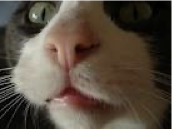Oral Cavity: lips, cheeks, gums & hard palate
1/17
There's no tags or description
Looks like no tags are added yet.
Name | Mastery | Learn | Test | Matching | Spaced |
|---|
No study sessions yet.
18 Terms
What is the function of the oral cavity and how is it carried out? (4)
Function:
Prehension (aid by lips and tongue)
Selection (due to taste buds on tongue)
Mastication (by muscles, teeth, tongue and mandible)
Insalivation (by salivary glands)
Location of the oral cavity
Extends from the lips to the entrance into pharynx
Which bones support the oral cavity?
Incisive bone
Palatine
Alveolar processes of maxilla
Mandible
Oral cavity is bounded rostrally by?
The lips
Oral cavity is bounded laterally by?
The cheeks
What is the roof of the oral cavity?
Hard palate and soft palate
What is located ventral to the oral cavity?
Tongue
What is under the oral cavity’s apex?
Floor of oral cavity (includes muscles and glands)
Caudally the oral cavity communicates with?
Oropharynx
What are the 2 types of spaces that are formed when the jaw is closed
Vestibule: space between lips/cheek and teeth/gums
Oral cavity proper: space inside the teeth
How does the 2 spaces (vestibule & oral cavity proper) communicate?
Via diastema (interdental space between incisors and cheek teeth)
What connects the oral cavity with the nasal cavity?
2 narrow incisive ducts
Describe the mucous membrane of oral cavity
Pink and well supplied with blood vessels
Submucosa of oral cavity contains which glands?
Serous or mucous glands known as
Labial glands (lips)
Buccal glands (cheek)
Lingual glands (tongue)
Lips
Assist in?
Attach to which bones
What are the 3 layers
Upper lip of carnivores and small ruminants is divided by
Assist in: Sucking and prehension of food
Attach to which bones:
Incisive bone
Incisive part of mandible
What are the 3 layers:
External layer (skin)
Middle layer (consist of muscles, tendons, CT and adipose tissue)
Internal layer (labial mucosa)
Upper lip of carnivores and small ruminants is divided by:
Philtrum which is a distinct median cleft

Cheeks #e1a500
Location
Caudal part of cheek contains which muscle
What are the 3 layers
In ruminants it forms
Location: From lateral wall of buccal vestibules
Caudal part of cheek contains which muscle: Massester muscle
What are the 3 layers:
Skin
Intermediate layer of glands and muscles
Buccal mucosa
In ruminants it forms: Cone-shaped cornified papillae that is present on lips
Gums
Location
In ruminant, it’s modified to form
Location: Encircles neck of teeth
In ruminant, it’s modified to form: Dental pad (replaces upper incisors)
Hard palate
What
In horse contains
Divided into
Mucosa is absent of?
What: Touch mucosa
In horse contains: Rich venous plexus
Divided into:
Median palatine raphe
Transversely directed palatine ridges
Mucosa is absent of: Glands
